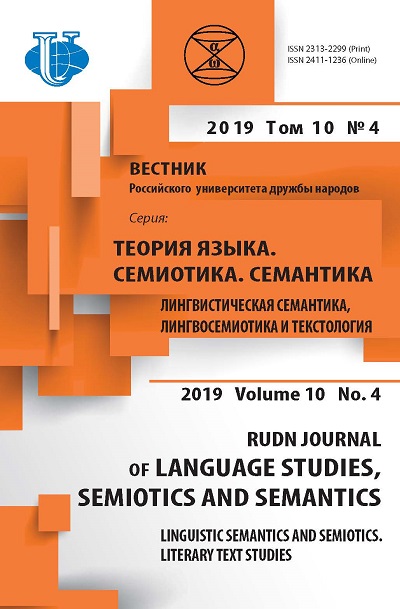Graphically Loanword from the Japanese Language in Modern Chinese Language
- Authors: Denisenko V.N.1, Ke Z.1
-
Affiliations:
- Peoples’ Friendship University of Russia (RUDN University)
- Issue: Vol 10, No 4 (2019): Linguistic Semantics and Semiotics. Literary Text Studies
- Pages: 740-753
- Section: FUNCTIONAL SEMANTICS
- URL: https://journals.rudn.ru/semiotics-semantics/article/view/22764
- DOI: https://doi.org/10.22363/2313-2299-2019-10-4-740-753
Cite item
Full Text
Abstract
This article is devoted to the study of Japanese loanwords in Chinese and their classification. Particular attention is paid to the lexical units in writing in Chinese characters, coming from the Japanese language as graphic loanwords in modern Chinese and Japanese, popular on the Chinese-language Internet. The material of the study is loanwords of Japanese origin, selected from dictionaries and scientific works on this topic, as well as word usage in messages on Russian and Chinese Internet forums. We distinguish between two types of Japanese loanwords in Chinese according to how they are borrowed: phonetic and graphic borrowed words. Graphic borrowed from the Japanese language, including the actual Japanese words spelled in Chinese characters, and words created by the Japanese using Chinese characters to convey tokens of other languages, as well as the words of the ancient Chinese language, rethought by the Japanese to create terms, then returned back to modern Chinese language, constitute a characteristic group of graphic loanwords in Chinese.
Keywords
About the authors
Vladimir N. Denisenko
Peoples’ Friendship University of Russia (RUDN University)
Author for correspondence.
Email: denisenko-vn@rudn.ru
DSc. in Philology, Full Professor, Head of the General and Russian Linguistics Department, Philological Faculty, RUDN University
6, Miklukho-Maklaya street, Moscow, 117198, Russian FederationZhang Ke
Peoples’ Friendship University of Russia (RUDN University)
Email: ke6831@yandex.ru
Post-graduate student of the General and Russian Linguistics Department, RUDN University
6, Miklukho-Maklaya street, Moscow, 117198, Russian FederationReferences
- 顾江萍 (2011). 汉语中的日语借词研究. 上海: 上海辞书出版社.
- 葛本仪 (2003). 现代汉语词汇学. 济南: 山东大学出版社.
- Trofimova, G.N. (2012). Problems of Internet Сommunication: Intercultural Aspect, RUDN Journal of Language Studies, Semiotics and Semantics, 3(1), 8—14. (In Russ).
- Melnikov, G.P. (1080). Lecture Notes on the Course “Introduction to Linguistics” (1979—1980). Moscow: Mashinopis. (In Russ).
- 史有为 (2003). 汉语外来词. 北京: 商务商务印书馆.
- 章太炎 (1984). 章太炎全集(三). 上海: 上海人民出版社.
- 高明凯, 刘正埮 (1958). 现代汉语外来词研究. 北京, 文字改革出版社.
- 王德春 (1983). 词汇学研究. 济南: 山东教育出版社.
- 王德春 (2002). 多角度研究语言. 北京: 清华大学出版社.
- 岑麒祥 (1990). 外来汉语词典. 北京: 商务印书馆.
- 张德新 (1993). 第三次浪潮一外来词引进和规范刍议 // «语言文字应用». 年第3期. 70—76页.
- 荣杰 (1998). 俄汉语言世界图景下的外来词研究 // «解放军外国语学院学报». 年第4期. 39—44页.
- 刘光准, 黄苏华 (1999). 俄汉语言文化习俗探讨. 北京: 外语教学与研究出版社.
- 杨锡彭 (2007). 汉语外来词研究. 上海: 上海人民出版社.
- 修刚 (2011). 外来词汇对中国语言文化的影响. 天津: 天津人民出版社.
- 金晶 (2014). 最新韩国语外来词解析. 北京: 世界图书.
- 马中红, 杨长征 (2016). 新媒介新青年新文化: 中国青少年网络流行文化现象研究. 北京: 清华大学出版社.
- 陈强 (2018). 基于社会语言学和语言文化学视角的俄语外来词研究 // «文化学刊». 年第10期. 191—913页.
- 李海燕. (2018). 英源外来词的引进与演变研究. 北京: 中国社会科学出版社.
- Zhang, Ke (2017). Definition of terminology Loanword in Russian and Chinese, RUDN Journal of Language Studies, Semiotics and Semantics, 8(3), 724—734. (In Russ).
- 刘正埮, 高名凯, 麦永乾, 史有为 (1984). 汉语外来词词典. 上海: 上海辞书出版社.
- 岑麒祥. (1990). 外来汉语词典. 北京: 商务印书馆.
- 夏征农, 陈至立 (2009). 中国综合性辞典«辞海». 上海: 上海辞书出版社.
- Perfilieva, N.V. & Hu, Peipei. (2012). Different Interpretations of the Loanword in Chinese Linguistic Works, Modern Research of Social Problems, 8. URL: http://sisp.nkras.ru/e-ru/issues/ 2012/8/hu.pdf (accessed: 21.09.2019).
- 万红 (2007). 当代汉语的社会语言学观照. 天津:南开大学出版社.
- Berkov, V.P. (1973). Questions of bilingual lexicography. St. Petersburg: Izdatel'stvo Leningradskogo universiteta. (In Russ).
- Aristova, V.M. (1985). English words in the Russian language: textbook. (In Russ).
- Panov, M.V. (2003). History of Russian Literary Pronunciation of the XV—XX centuries. Moscow: Editorial URSS. (In Russ).
- Krysin, L.P. (1968). Foreign Words in Modern Russian. Moscow: Nauka. (In Russ).
- 董政民 (2015). 英语日语外来词词典. 上海: 上海译文出版社.
- 现代汉语词典 (2012). 商务印书馆创立 115 年纪念版. 中国社会科学院语言研究所词典编辑室编. 北京:商务印书馆.
- 高名凯, 刘正埮, 麦永乾, 史有为 (1984). 汉语外来词词典. 上海: 上海辞书出版社.
- 温玉晶 (2016). 日语外来语与日语语言文化特点探讨. «明日风尚».
- 百度百科 URL: https://baike.baidu.com (accessed: 21.09.2019).
- 现代汉语词典 (2016). 第七版. 中国社会科学院语言研究所词典编辑室编. 北京:商务印书馆.













